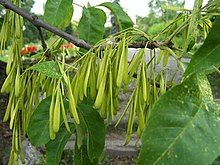Green Ash
| Fraxinus pennsylvanica | |
|---|---|
 |
|
| Leaves and fruit | |
| Scientific classification | |
| Kingdom: | Plantae |
| (unranked): | Angiosperms |
| (unranked): | Eudicots |
| (unranked): | Asterids |
| Order: | Lamiales |
| Family: | Oleaceae |
| Genus: | Fraxinus |
| Species: | F. pennsylvanica |
| Binomial name | |
|
Fraxinus pennsylvanica Marshall |
|
 |
|
| Natural range of Fraxinus pennsylvanica | |
Fraxinus pennsylvanica (green ash or red ash) is a species of ash native to eastern and central North America, from Nova Scotia west to southeastern Alberta and eastern Colorado, south to northern Florida, and southwest to Oklahoma and eastern Texas. It has spread and become naturalized in much of the western United States and also in Europe from Spain to Russia.
Fraxinus pennsylvanica is a medium-sized deciduous tree reaching 12–25 m (39–82 ft) (rarely to 45 m or 148 ft) tall with a trunk up to 60 cm (24 in) in diameter. The bark is smooth and gray on young trees, becoming thick and fissured with age. The winter buds are reddish-brown, with a velvety texture. The leaves are 15–30 cm (6–12 in) long, pinnately compound with seven to nine (occasionally five or eleven) leaflets, these 5–15 cm (2–6 in) (rarely 18 cm or 7 in) long and 1.2–9 cm (1⁄2–3 9⁄16 in) broad, with serrated margins and short but distinct, downy petiolules a few millimeters long. They are green both above and below. The autumn color is golden-yellow and depending on the climate, Green Ash's leaves may begin changing color the first week of September. The flowers are produced in spring at the same time as the new leaves, in compact panicles; they are inconspicuous with no petals, and are wind-pollinated. The fruit is a samara 2.5–7.5 cm (1–3 in) long comprising a single seed 1.5–3 cm (5⁄8–1 1⁄8 in) long with an elongated apical wing 2–4 cm (3⁄4–1 1⁄2 in) long and 3–7 mm (1⁄8–9⁄32 in) broad.
...
Wikipedia
